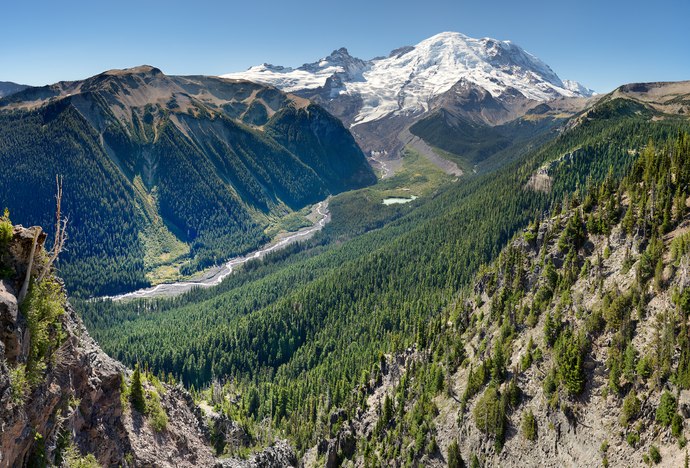In south-central Washington State, 14,411-foot Mt. Rainier's commanding presence captivates observers up to 300 miles away. That is, when it is cloud-free. Moisture from the Pacific Ocean condenses on the persistently cloud-covered flanks of this volcano. As a result, the mountain is "out" only one day in four and is one of the snowiest places on the planet.
Taken from the Emmons Glacier Overlook on a rare cloudless morning, this photograph captures 10,000 feet of vertical gain from the White River to Rainier's peak. Fifty-eight hundred years ago, weakened by underground fissures expelling heated and erosive gases, the mountain's northeast side slowly fractured and crumbled. Most likely triggered by a slide of weakened rock from the mountain's summit, the Osceola Mudflow moved a cubic mile of liquified rock down through the White River Valley. Splashing up its walls as high as this overlook, it rapidly drained clay, rocks, and debris into the Pacific Ocean. Rubble-encrusted Emmons Glacier formed in the newly excavated cirque, expanding and contracting over the five millennia since the mudflow, feeding the White River and carving a valley that became carpeted by Pacific Silver Firs after the last ice age.
A 1922 park brochure described Mt. Rainier as looking like "an octopus of ice." Poet Marianne Moore visited the park that year accompanied by her mother, brother, and a copy of the park's brochure. Published in 1924, her poem "An Octopus" contained quotes from, and was drafted inside, that brochure. Her radical and complex meditation about the mountain begins:
- An Octopus
- of ice.
- Deceptively reserved and flat,
- it lies "in grandeur and in mass"
- beneath a sea of shifting snow-dunes;
- dots of cyclamen-red and maroon on its clearly defined
- pseudo-podia
- made of glass that will bend--a much needed invention--
- comprising twenty-eight ice-fields from fifty to five hundred
- feet thick,
- of unimagined delicacy.

